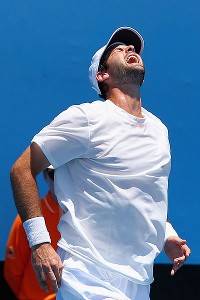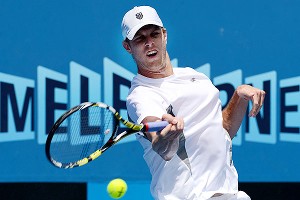MELBOURNE, Australia -- By rights, Brian Baker should have gotten all of his bad fortune out of the way. Multiple surgeries on his hips, one on his elbow and a hernia repair kept the former top junior out of the elite ranks for six years.
One area of his body that had never given him any trouble was his knees -- until the injury gods hurled another bolt of lousy lightning at him Wednesday.
[+] Enlarge
Chris Hyde/Getty ImagesBrian Baker grimaces after injuring his knee in the second set of his match against fellow American Sam Querrey.
Baker had won a first-set tiebreak from compatriot Sam Querrey in their Australian Open second-round match on a breezy outer court whose surface, Querrey would later say, was the quickest he's played on at a Slam. Tied 1-all on Querrey's serve in the second, Baker went to fetch a backhand, took a step or two back toward the center of the court and appeared to stumble, then seize up, grimacing in pain. He couldn't put weight on his right leg and hobbled toward his chair.
Moments later, the two friends shook hands and the chair umpire announced the match was over. Baker told Querrey he thought he heard "a pop or a snap" and that from one second to the next, he couldn't straighten his knee. Baker slumped dejectedly with a towel over his head, waiting for a wheelchair to ferry him away. A sideline microphone picked up some of his conversation with the trainer as he described the sensation of "something rubbing back and forth."
"How does this happen?" Baker said at one point.
How indeed? Bad enough that two American men had to collide this early in the draw in the first Grand Slam event of this transitional, post-Andy Roddick era, but Baker had hiked an awfully long way up the mountain to backslide through no fault of his own again.
The 25-year-old, 20th-seeded Querrey is the top U.S. player in the draw thanks to John Isner's injury-related withdrawal. But Querrey made it clear to reporters after winning a four-set, first-round match against Spanish qualifier Daniel Munoz-De La Nava that status isn't weighing on him.
"Whatever pressure he feels is what he puts on himself," said his coach, David Nainkin. "He's got his own goals. He's well-prepared, he's healthy, he's in a good place.
"Today, the court definitely favored Brian. Sam likes a higher bounce. It was good, clean hitting, and Brian has great timing. I thought their level was getting better through the [first] set. It would have been a good match. It's just a shame."
Querrey has never thrived at this event, reaching the third round twice in six previous appearances and bowing out in the first round three straight times from 2009 to '11. Much as he'd like to go deeper, Wednesday's sequence of events was the opposite of the scenario he would have wanted.
[+] Enlarge
Greg Wood/AFP/Getty ImagesAmerican Sam Querrey now faces Switzerland's 15th-seeded Stanislas Wawrinka, who also advanced because of a player retirement.
"I feel awful for him," Querrey said of Baker. "He's the last person that deserves anything like that with his five or six surgeries already. He does everything right, treats his body great, just trying to come back, and then something like that happens, it's just so unlucky."
An MRI revealed Baker has a torn lateral meniscus that will require surgery and roughly three to four months of rehab. Tournament director Craig Tiley said Baker likely will fly back to the United States in the next day or two.
Baker, a Nashville, Tenn., native, charmed the tennis world last year with his climb out of obscurity to striking distance of the top 50 -- a neighborhood in which Querrey said he belongs.
Playing in his first Australian Open main draw, Baker earned the first five-set win of his career in his opening match against Russian qualifier Alex Bogomolov Jr. and was looking for another milestone against Querrey in the form of a tour-level win against a fellow U.S. player. Isner's questionable near-term status also had positioned Baker for possible nomination to the U.S. Davis Cup team for next month's tie against Brazil.
Querrey has been a break-even player at Grand Slam events (he's now 25-23 lifetime), and is still looking to parlay his big serve and forehand into a trip to the later rounds. His best performances have come at the U.S. Open, where he has twice made the fourth round, and Wimbledon, where last year he fell in a memorable five-set, 5 1/2-hour third-round marathon to Croatia's Marin Cilic.
Complete results
 Need the scores from any match played in the Australian Open? Results
Need the scores from any match played in the Australian Open? Results
The Californian showed just how lethal -- and determined -- he can be at October's Paris Masters, where he eliminated then-world No. 2 Novak Djokovic in three sets, coming back from a love set to win 7-6 (5), 6-4.
He said he is fitter than he has ever been, partly due to a strict recovery regime he has been following since last June that involves "500 percent" more attention than he used to devote.
"I feel I can go five sets," he said. "I'm not worried about fatiguing at all. I spend two and a half hours on the table every day stretching before practice, stretching after practice."
He might need all that stamina against Switzerland's 15th-seeded Stanislas Wawrinka, who also advanced because of a player retirement. Wawrinka outlasted Querrey on a windy, hot day in five sets in the fourth round of the 2010 U.S. Open and won their only other encounter, at Indian Wells the year before.
"He's going to be a tough guy to play," Nainkin said.
Bonnie D. Ford covers Olympic sports for ESPN.com.
denver broncos vs new england patriots cruise ship sinking vernon davis starship troopers starship troopers cruise ship italy patriots broncos game
কোন মন্তব্য নেই:
একটি মন্তব্য পোস্ট করুন